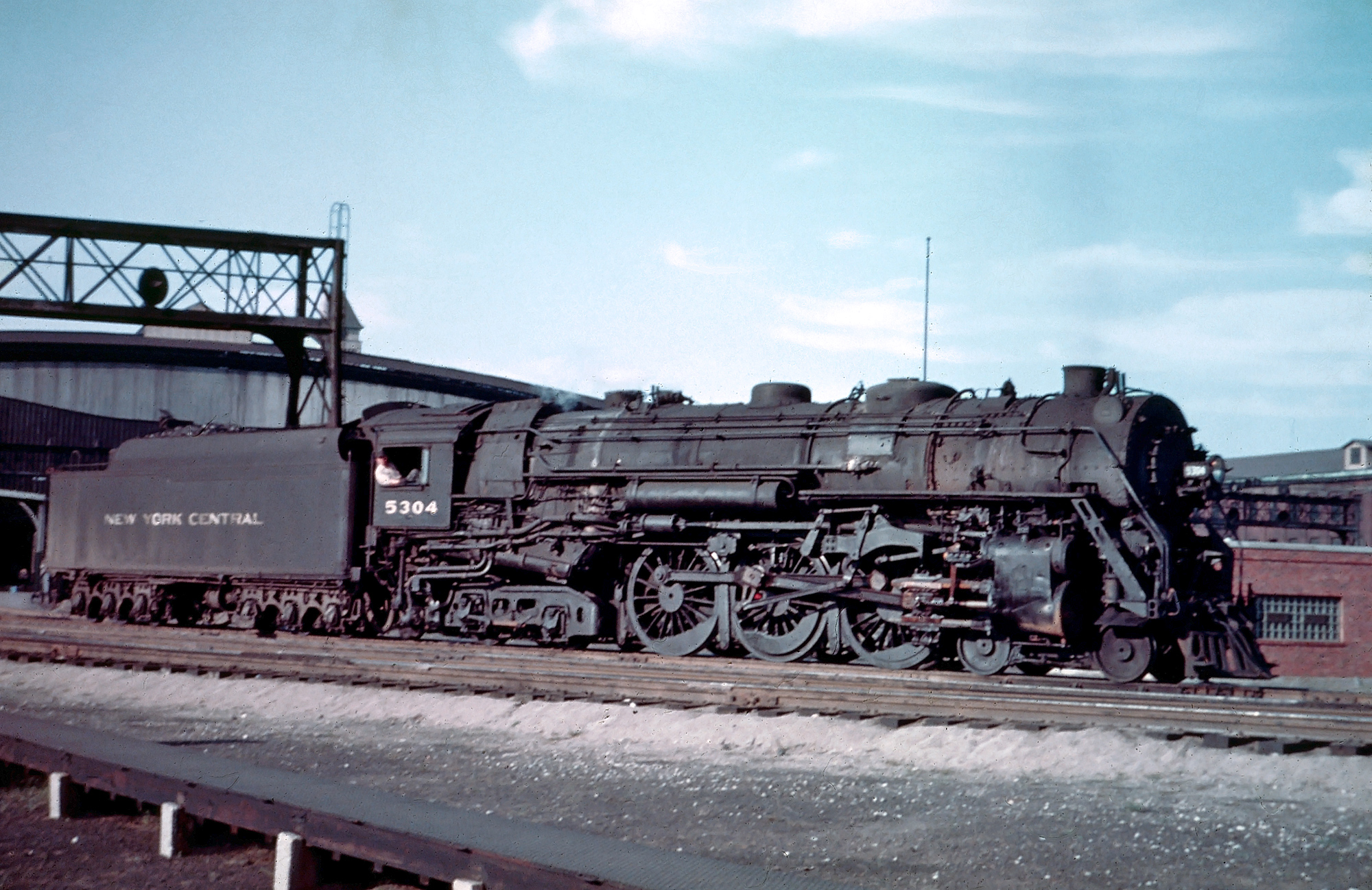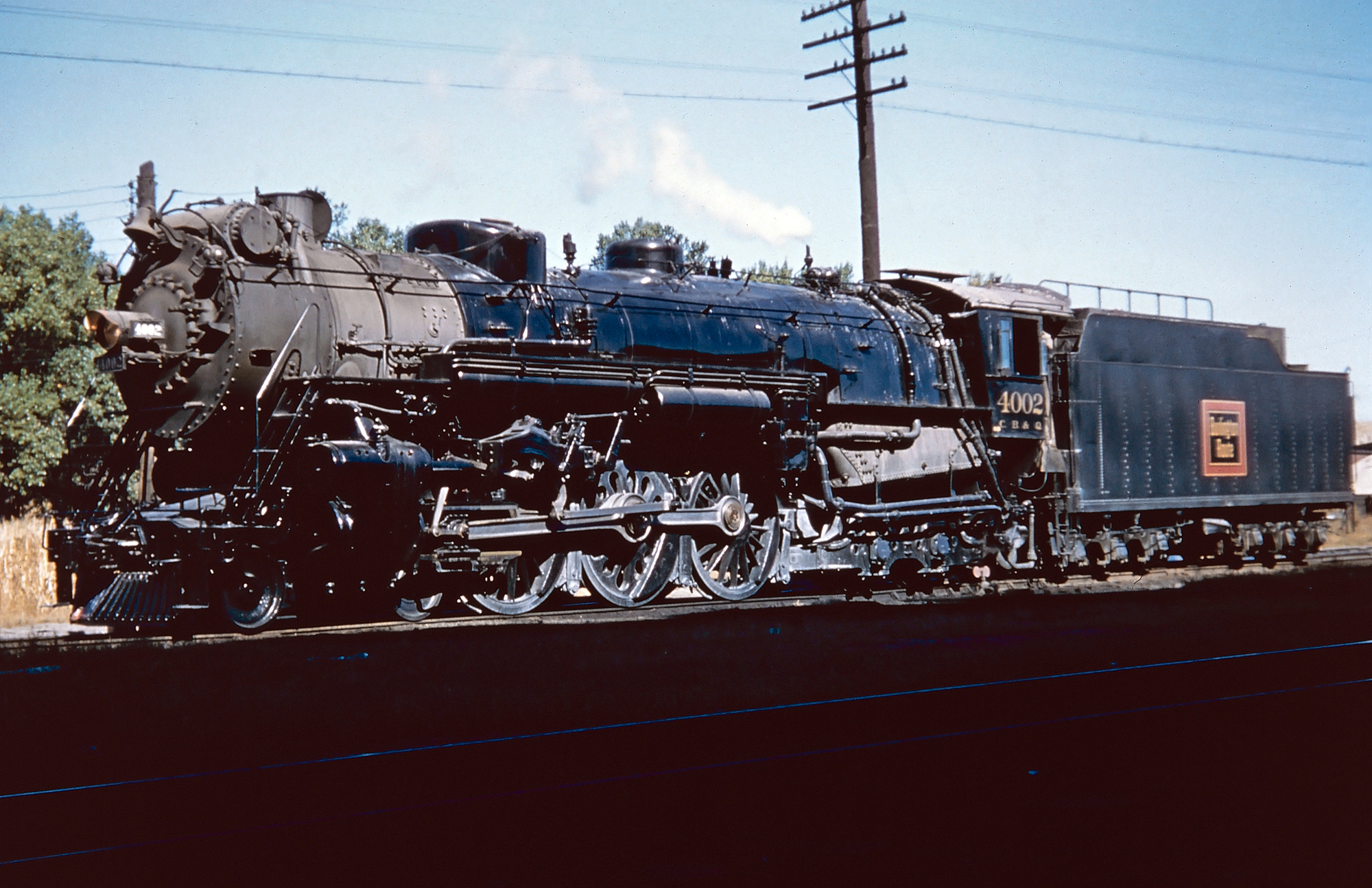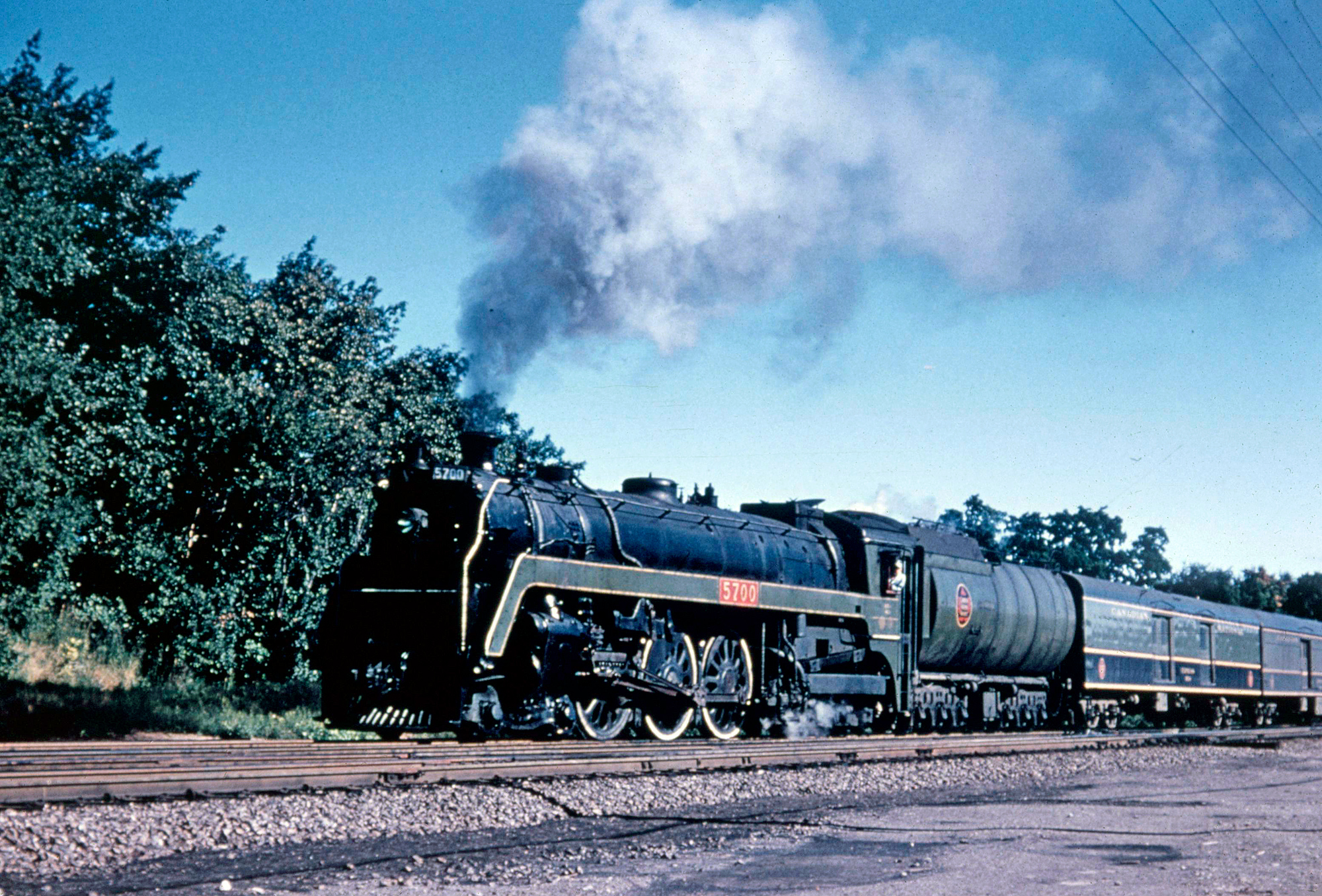4-6-4 "Hudson" Locomotives: History, Survivors, Photos
Last revised: November 6, 2024
By: Adam Burns
Introduced during the height of the Super Power era, the 4-6-4, known affectionately as the "Hudson," is a hallmark of the New York Central’s illustrious history. This innovative design quickly became synonymous with the New York Central, which was instrumental in its development and subsequent rise to fame.
The NNYC enhanced the Hudson’s iconic status through a successful collaboration with renowned industrial designer Henry Dreyfuss. Dreyfuss lent his expertise to streamline the locomotive, epitomizing the elegance and dynamism of the era.
This design enhancement was specifically tailored for the railroad’s prestigious passenger service, the 20th Century Limited, further cementing the Hudson's reputation as a symbol of sleek, modern American railroading during its golden age.
In the 1920s, the New York Central (NYC) identified a pressing demand for a more potent steam locomotive capable of hauling increasingly heavier and larger passenger trains—a task that its fleet of Pacifics could no longer manage.
This need led to the development of the 4-6-4 wheel arrangement, famously known as the "Hudson." Demonstrating remarkable success, the series quickly became a cornerstone of NYC's engine roster, with nearly 300 units serving the bustling line.
The Hudson's efficiency and power did not go unnoticed, and soon nearly two dozen other rail lines acquired at least one for their services. Today, the legacy of the Hudson endures as several units have been preserved. These locomotives continue to captivate enthusiasts and historians alike, serving as enduring symbols of the golden age of steam railroading.
Photos
 The engineer of New York Central 4-6-4 #5304 poses with his locomotive at St. Louis Union Station, circa 1950. This was one of hundreds of Hudsons the NYC employed in passenger service. Fred Byerly photo. American-Rails.com collection.
The engineer of New York Central 4-6-4 #5304 poses with his locomotive at St. Louis Union Station, circa 1950. This was one of hundreds of Hudsons the NYC employed in passenger service. Fred Byerly photo. American-Rails.com collection.Development
By the 1920s, the New York Central faced a significant challenge. Its fleet of Class K-5 Pacifics, the standard in passenger power at the time, was finding it increasingly difficult to handle the burgeoning weight of new passenger equipment and the growing demands of the traveling public.
Recognizing the need for innovation, Paul Kiefer stepped into the role of Chief Mechanical Engineer of Motive Power and Rolling Stock at NYC on January 1, 1926. Kiefer quickly identified the necessity for a more capable locomotive to meet the evolving needs of the railroad.
In collaboration with the American Locomotive Company (Alco), Kiefer spearheaded the development of a new locomotive design, the 4-6-4. This design was essentially an enhanced version of the Pacific, featuring an additional rear axle which supported a larger firebox and boiler.
This expansion enabled not only a significant increase in steaming capacity but also allowed the locomotive to operate at a higher boiler pressure of 225 psi, providing markedly greater power and efficiency. The innovations embedded in this new design would soon prove to be a pivotal advancement for the New York Central’s passenger services.
Initial Testing
On February 14, 1927, the New York Central (NYC) proudly debuted its first locomotive of the Class J-1a, marking a groundbreaking advancement over the previous K-5 Pacific. The superior capabilities of the new 4-6-4 design became immediately evident.
Initial performance tests, conducted along the NYC’s principal route between Albany and Syracuse, showcased the locomotive’s enhanced power and efficiency.
The Class J-1a demonstrated a remarkable ability to haul 16 to 18 heavyweight cars at speeds that surpassed those of the K-5, which had been limited to managing approximately 12 cars per train. This significant improvement not only highlighted the success of the new design but also set a new standard in railroad locomotive performance.
In a nod to the scenic route paralleling its main line from New York City to Albany, the railroad aptly named the new locomotive class after the Hudson River. This decision not only honored the geographical essence of the route but also anchored the locomotive’s identity in the rich narrative of the region it served.
Following the successful introduction in 1927, the New York Central continued to expand its fleet of Hudson locomotives, extending purchases all the way through to 1937.
The majority of these powerful locomotives were built by Alco and included several classes such as J-1, J-2a, and J-3.
Meanwhile, Lima Locomotive Works also contributed to the Hudson legacy by producing the Class J-2c in 1930, which consisted of ten units initially numbered 610-169, further enriching the diversity and capability of the NYC's locomotive roster.
Success
The New York Central famously held the largest collection of Hudson locomotives, boasting a total of 275 units.
This impressive ensemble included 195 locomotives directly owned by the NYC, complemented by an additional 80 across its subsidiaries—Boston & Albany, Big Four, and Michigan Central.
However, the allure of the Hudson design extended beyond the NYC, as several other railroads also embraced this locomotive model, either through purchase or their own production efforts.
Alco and its subsidiary, Montreal Locomotive Works, were pivotal in manufacturing most of the Hudsons, serving prominent Canadian railroads like Canadian National and Canadian Pacific—the latter possessing the second-largest fleet with 65 units.
Not to be outdone, other notable locomotive builders such as Lima and Baldwin also contributed to the Hudson legacy by producing these 4-6-4 locomotives.
The Milwaukee Road also showcased a significant commitment to the Hudson type during the early 1930s. Between 1930 and 1931, the railroad acquired 22 examples from Baldwin, designated as Class F-6 and F-6a, which were specifically employed in passenger service.
This fleet not only enhanced the operational capacity of the Milwaukee Road but also underscored the widespread appeal and adaptability of the Hudson locomotives in passenger rail service across North America.
 Chicago, Burlington & Quincy 4-6-4 #4002 (Class S-4B) was photographed here at Omaha, Nebraska in the summer of 1956. American-Rails.com collection.
Chicago, Burlington & Quincy 4-6-4 #4002 (Class S-4B) was photographed here at Omaha, Nebraska in the summer of 1956. American-Rails.com collection.The Milwaukee Road embarked on a unique branding strategy for their locomotives, opting to name them Baltics rather than Hudsons, a distinction that underscored their distinct operational requirements and marketing approach. In a significant enhancement of its fleet, in 1938, the Milwaukee Road acquired an additional six 4-6-4 locomotives from the American Locomotive Company (Alco).
These locomotives, some of the fastest ever built, were designated to power the esteemed and swift regional Hiawatha services. This strategic acquisition marked a transition from the railroad's home-built 4-4-2 Atlantics, heralding a new era of speed and efficiency.
Additionally, the Santa Fe railroad also played a noteworthy role in the history of the Hudson type locomotives. Originally, in 1927, Santa Fe introduced ten Hudsons built by Baldwin, numbered 3450-3459 and classified as the 3450 Class.
A decade later, these locomotives underwent significant modifications, enhancing their performance and extending their service life in the increasingly competitive rail industry. The widespread adoption and subsequent adaptations of the Hudson type across various railroads underscore their significant impact and enduring legacy in North American railroading.
The Santa Fe further expanded its fleet of 4-6-4 locomotives in 1937 with the acquisition of six more units from Baldwin. These were designated as the 3460 Class and epitomized the Super Power concept with enhancements such as roller bearings, a larger boiler, higher boiler pressure, and increased tractive effort, signaling a new era of locomotive technology.
Among this prestigious class, the #3460 stood out as the only streamlined variant, dressed in an eye-catching two-tone Robin Blue livery accented with stainless steel trim.
This locomotive earned the affectionate nickname "Mae West" from AT&SF crews, though it is most famously remembered as the "Blue Goose" and sometimes referred to as the "Blue Bird."
The #3460 was a frequent leader on noteworthy routes such as the Grand Canyon Limited, the Chief, and the Scout, where its distinctive appearance and robust performance captivated both rail enthusiasts and passengers alike.
 A handsome Canadian National 4-6-4, #5700, has westbound train #77 (London - Detroit, Michigan) at Bayview, Ontario during the 1950's. Paul Meyer photo. Author's collection.
A handsome Canadian National 4-6-4, #5700, has westbound train #77 (London - Detroit, Michigan) at Bayview, Ontario during the 1950's. Paul Meyer photo. Author's collection.Preservation
Developed in the late 1920s, the Hudson served the railways with distinction but typically retired after about 30 years of service during the 1950s.
Despite this, their legacy endures, as several models have been meticulously preserved. Notably, most of the preserved U.S. Hudsons were originally operated by the Chicago, Burlington & Quincy, along with several from Canadian railroads.
One particularly prominent preserved specimen is the C&O #490. This entirely streamlined locomotive is celebrated for its role in pulling some of the railroad's most renowned passenger trains, including the celebrated George Washington. Its preservation allows both enthusiasts and historians to appreciate its contribution to the golden era of American rail travel.
U.S. Examples
| Engine Number | Class | Wheel Arrangement | Track Gauge | Original Owner(s) | Current Location | Current Status | Builder Information | Notes |
|---|---|---|---|---|---|---|---|---|
| 490 | L1a | 4-6-4 | 4' 8 ½" | Chesapeake & Ohio | B&O Railroad Museum (Baltimore) | Display | Alco-Richmond #66555 (1926) | Rebuilt from an F-19 class Pacific. |
| 3003 | S-4 | 4-6-4 | 4' 8 ½" | CB&Q | South Main Street (Burlington, Iowa) | Display | Baldwin #61501 (1930) | Participated in Burlington's steam program. |
| 3006 | S-4 | 4-6-4 | 4' 8 ½" | CB&Q | Galesburg Railroad Museum (Galesburg, Illinois) | Display | Baldwin #61527 (1930) | - |
| 4000 (3002) | S-4A | 4-6-4 | 4' 8 ½" | CB&Q | Copeland Park (LaCrosse, Wisconsin) | Display | Baldwin #61500 (1930) | Named 'Aeolus'. |
| 3001 | S-4 | 4-6-4 | 4' 8 ½" | CB&Q | Ballingall Park (Ottumwa, Iowa) | Display | Baldwin #61446 (1930) | - |
| 3450 | 3450 | 4-6-4 | 4' 8 ½" | AT&SF | RailGiants Train Museum (Pomona, California) | Display | Baldwin #59993 (1927) | - |
| 47 (1542) | X-10-a | 4-6-4T | 4'-8½" | Grand Trunk Railway (Canadian National) | Steamtown National Historic Site (Scranton, Pennsylvania) | Display | Montreal Locomotive Works (1914) | - |
| 170 | L-1a | 4-6-4 | 4' 8 ½" | New York, Chicago & St. Louis (Nickel Plate) | Museum of Transportation (St. Louis) | Display | Alco-Brooks #67211 (1927) | - |
| 2839 | H1c | 4-6-4 | 4' 8 ½" | Atlantic Central (Canadian Pacific) | The Nethercutt Collection and Museum (Sylmar, California) | Display | Montreal Locomotive Works (1937) | - |
| 3463 | 3460 | 4-6-4 | 4' 8 ½" | Santa Fe | Kansas Expocenter (Topeka) | Display | Baldwin #62086 (1937) | - |
| 3007 | S-4 | 4-6-4 | 4' 8 ½" | CB&Q | Illinois Railway Museum (Union) | Display | Baldwin #61528 (1930) | - |
Canadian Examples
| Engine Number | Class | Wheel Arrangement | Track Gauge | Original Owner(s) | Current Location | Current Status | Builder Information | Notes |
|---|---|---|---|---|---|---|---|---|
| 2816 | H1b | 4-6-4 | 4' 8 ½" | Canadian Pacific-Kansas City (Canadian Pacific) | Ogden Shops, Calgary, AB | Operational | Montreal Locomotive Works #68535 (1930) | Equipped with Positive Train Control. |
| 2850 | H1d | 4-6-4 | 4' 8 ½" | Canadian Pacific | Canadian Railway Museum (Delson, Quebec) | Display | Montreal Locomotive Works #69100 (8/1938) | - |
| 5702 | K-5-a | 4-6-4 | 4' 8 ½" | Canadian National | Canadian Railway Museum (Delson, Quebec) | Display | Montreal Locomotive Works #68396 (1930) | - |
| 49 | X-10-a | 4-6-4T | 4' 8 ½" | Canadian National | Canadian Railway Museum (Delson, Quebec) | Display | Montreal Locomotive Works (1914) | - |
| 2858 | H1d | 4-6-4 | 4' 8 ½" | Canadian Pacific | Canada Science and Technology Museum (Ottawa, Ontario) | Display | Montreal Locomotive Works #69108 (1938) | - |
| 2860 | H1e | 4-6-4 | 4' 8 ½" | CPR | West Coast Railway Heritage Park, Squamish, BC | Displayed Operational | Montreal Locomotive Works (1940) | - |
| 5700 (5703) | K-5-a | 4-6-4 | 4' 8 ½" | Canadian National | Elgin County Railway Museum (St. Thomas, Ontario) | Display | Montreal Locomotive Works #68540 (1930) | - |
| 46 | X-10a | 4-6-4T | 4' 8 ½" | Canadian National | Centre d'Interpretation Ferroviaire (Vallee-Jonction, Quebec) | Restoration | Montreal Locomotive Works (1914) | - |
Sources
- Boyd, Jim. American Freight Train, The. Osceola: MBI Publishing, 2001.
- Solomon, Brian. Alco Locomotives. Minneapolis: Voyageur Press, 2009.
- Solomon, Brian. Classic Locomotives, Steam And Diesel Power in 700 Photographs. Minneapolis: Voyageur Press, 2013.
- Solomon, Brian and Schafer, Mike. New York Central Railroad. St. Paul: Andover Junction Publications, 2007.
Recent Articles
-
Rio Grande 2-8-2 Locomotives (Class K-28): Specs, Roster, Photos
Apr 14, 25 10:24 PM
Rio Grande's Class K-28 Mikados were its newest narrow-gauge steam locomotives since the Mudhens of the early 1900s. Today, three survive. -
Rio Grande K-27 "Mudhens" (2-8-2): Specs, Roster, Photos
Apr 14, 25 05:40 PM
Rio Grande's Class K-27 of 2-8-2s were more commonly referred to as Mudhens by crews. They were the first to enter service and today two survive. -
C&O 2-10-4 Locomotives: Specs, Roster, Photos
Apr 13, 25 04:07 PM
Chesapeake & Ohio's T-1s included a fleet of forty 2-10-4 "Texas Types" that the railroad used in heavy freight service. None were preserved.


